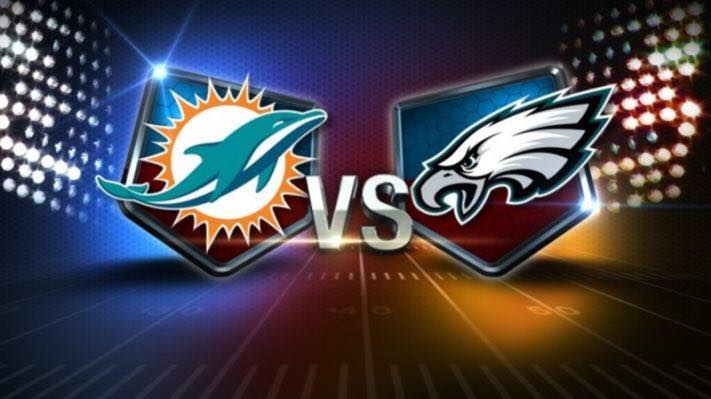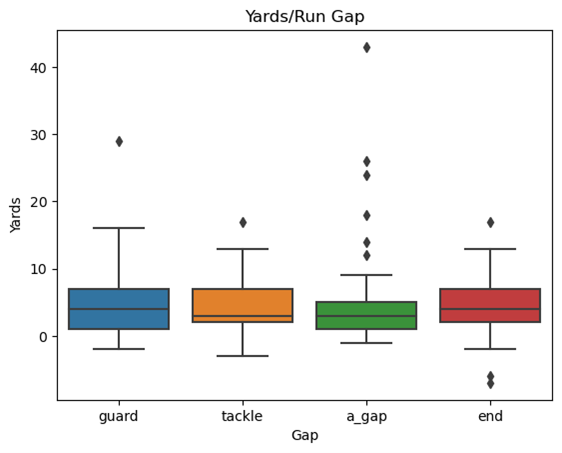
After starting off slow, your regularly schedule program started and didn’t stop until the game ended against the panthers. Quite honestly there’s not too much to say about the Dolphins last week matchup against the Panthers, outside of the fact they came out playing very conservative and were punished for it. When looking at this upcoming matchup it’s more important to look at the opponent, being the Eagles.
Panthers Game Learnings
After starting off down 14 – 0 Miami played a near flawless game, the reason for that slow start can be attributed to their passiveness on the 1st couple of offensive drives on offense. Coupled with individual players making mistakes allowing for a couple big plays on otherwise well-guarded plays and defended drives. The goal of this isn’t to look too much into individual personnel play, so let’s take a look more at the offensive side of the ball. The first drive starts with a tunnel screen to Jaylen Waddle, a passive call that allows the defense to be right. This is because our offense is designed to attack the edges in the run and short pass game, it’s one of our strengths, so on the 1st play of the game which is a “running down” the defense is naturally going to be playing in those lanes unless they are specifically accounted for by the offense. They were not, and because of this the Panthers MLB was able to beat Robert Hunt to his spot tackling Waddle for a short game. We’ve seen the most success with these screens on atypical running downs, this is because our pass game attacks a very different part of the field allowing these screens to take advantage of the way defenders are playing when they expect pass. The second play was a standard quick toss play, again allowing the defense to be right while also being a conservative call. This play was called against Carolina’s standard nickel front which is a 3-3-5 wide front, this aligns the DL across the 2 offensive tackles and the center with outside linebackers on the line of scrimmage farther wide. This defense is trying to set the edge and create clear lanes for the MLB, we played right into that. Often times this year on this style of play we’ve seen Miami crack block the edge defenders with a slot WR to out leverage the edge and attack that space with speed allowing blocks in space with a fullback or TE on DBs which is a positive matchup. I’d suspect, we might’ve been one step ahead of ourselves but should’ve just run this play how we’ve ran it all year. This puts the Dolphins in a 3rd and 10 which Tua (maybe prematurely) takes his checkdown and moves on to the next drive.
The next drive begins with a double spot/spacing style of play, designed to attack zone underneath and while not an inherently bad call it is a safe easy call for an offense that doesn’t need to be. This is where really where the passiveness ends, as the next play-call is a dive up the middle which isn’t overtly passive considering it was 2nd & 3, and the final play of the drive was a trick play which was the failed fake QB sneak. This is a play I wanted to talk about briefly, because it’s a play I fundamentally like and agree with the call regardless of what the outcome is. Yes, it did not work, however, it failed because of a slight miscommunication not due to a failure of concept. Faking the QB sneak, pulls the entire defense towards the middle. The play then seeks to attack the edges with speed and a blocker creating a 2-on-1 and a potentially MASSIVE play is Mostert can break one tackle in open space which he has shown all season the ability to do so.
Reviewing Eagles Tape
In watching the past few Eagles games, there’s something apparent that stands out from their offensive tape. Jalen Hurts has a pre-snap tell as to when he’s snapping the ball, Hurts get’s in a low stance in preparation for the snap and in doing so often raises and lowers his right leg right before the ball is snapped. Now, there’s a few obvious assumptions you can think to make here. They all seem to be wrong, because it appears that the Eagles know this tell exists. The most obvious clue is that it was not appearing in every game this season, but there’s more. On certain plays you can see MLBs keying in on this tell when they’re blitzing and Hurts has held the snap an extra half second to get those players out of position. The question now becomes, how is this helpful then? The answer is simple yet complicated, let’s focus on the simple parts first. If Hurts starts the game, with this “tell” it’ll be fair to assume he’ll keep it up the rest of the game, often times he’ll drop as if he’s preparing to snap the ball to try and bring the defense out of their disguise or draw the DL offsides. When he does this, he VERY often doesn’t show this tell, so the first takeaway is don’t move until Hurt’s right leg moves. The second takeaway assuming Philly knows the gambit they’re taking with this tell, is to read is aggressively early and on 2nd & longs. It’s fair to assume this is shown in order to create free plays and make big downs easier, to do this correctly they will have to convince the defense this tell is real. Making big downs where the offense isn’t trying to convert on this are key to winning this mini-game. Optimally, it’s better to then soften on this tell later after it has already been capitalized early, in my opinion this isn’t something you want to save until late and then be on the wrong end of. Especially when you have a team that’s so good at getting a lead and keeping it.
The 2nd thing to point out from the film is that Miami needs to attack the right side of the Eagles offensive line. With Lane Johnson out, they will already be with a backup. Alongside that, it’s very clear Hurts would rather work outside of structure toward his throwing arm. Forcing him to roll left, puts him in situations he’s less comfortable doing. This offense when passing runs very much as a 2-read offense, followed by a let’s make something happen out of structure. You can weaken the entire last phase of that by forcing Hurts to his weakside and spying him or converting zones over the middle into spy’s after a certain length of time on given plays.
Analyzing the Data
Looking at the numbers it’s clear the Eagles are confident in their offensive line, with a clear preference towards running up the middle. Thus, this is where you see most of their explosive run plays, combined with a back who’s willing to be patient and wait for the gap to open it’s clear why they’ve had success running up the middle.

It is worth noting that these numbers are probably slightly skewed due to the “tush push” used in 3rd/4th & short scenarios often as they believe no one can stop this play and use is almost regardless in these scenarios. Not to mention Hurt’s is given designed runs up the middle as well adding to those numbers. Regardless, this should be an area of focus to force this offense to play out of their comfort zone.
In viewing Philly’s defense, one thing stands out very clearly. They give up no explosive runs, that chart ends after 17 yards meaning they do not give up big runs at all. Meanwhile our offense generates massive gains on runs like it’s an easy thing to do. This will be a very interesting matchup between an unstoppable force and immovable object. The one factor that may indicate that advantage favors Miami is that they are very clearly weakest to runs that attack the edge an area that the Dolphins like to attack the most. With the amount of man coverage the Eagles like to run, it would be interesting to see if the Dolphins take the approach of running draw plays to take advantage of DBs turning their back on a run play.

